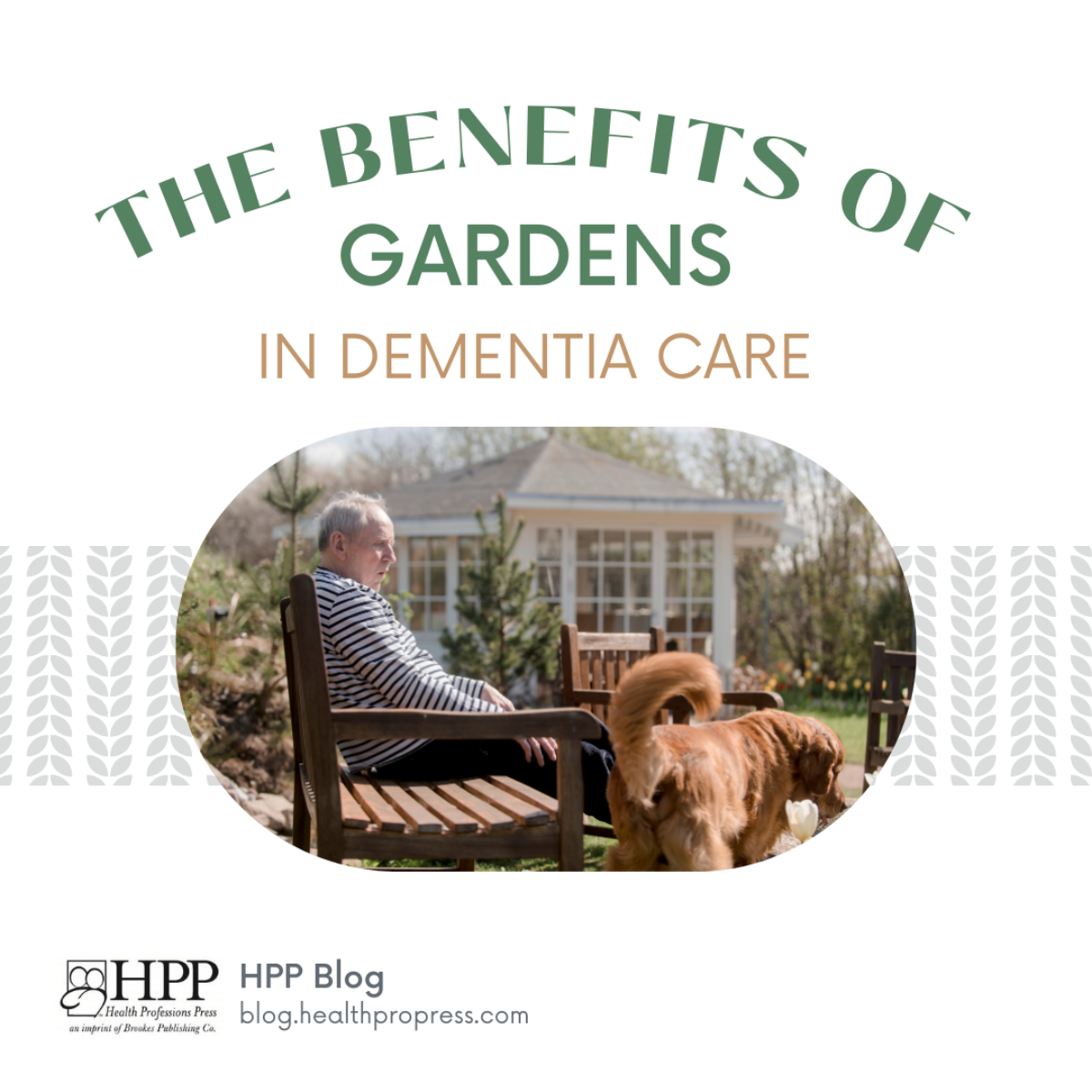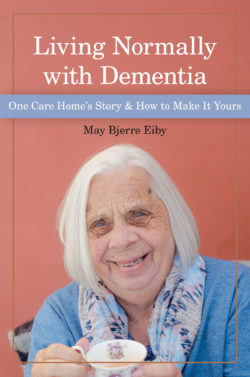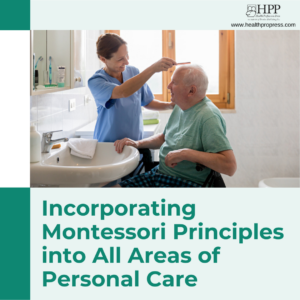
The Benefits of Gardens in Dementia Care
Saying “hello” to the outside world, for even a brief moment, is vital. The truth is, trips outside, whether to the garden at the home or to a nearby forest or nature trail, are beneficial for both the residents and the employees. It does us all good to get a little air and light, and being out in nature can remind our residents, and ourselves, of our connectedness to something greater than ourselves. I am not sure why so many people assume that working at a nursing home means staying indoors. Let people go outside; it is good for all of us.
The Norm: The “Stress Garden”
Many nursing homes advertise their “sensory gardens.” Originally, a sensory garden was a place filled with herbs, scents of flowers in many different colors, and cozy spaces with tables and benches where you could soak up all the sights, sounds, and delights of the garden. Throughout history, hospitals have had these types of gardens on their grounds because sitting in the sun and experiencing the many things a garden has to offer can help rejuvenate people who are ill.
Unfortunately, the term sensory garden no longer seems to mean the same thing it did historically. Once the concept went mainstream, retailers took over, along with a wide range of merchandise. Once again, the care sector was swept off its feet by all the advances in technology, and these days gardens are filled with contraptions where the residents can push a button and hear music or nature sounds. I have even seen “dementia-friendly” plastic animals; residents can get up close and pet the “cows.” It is simply deceptive.
Nursing homes will purchase expensive architect-designed “sensory furniture,” such as outdoor sofa hammocks and swings. These are as hard for me to fathom as they are hard for the residents to get out of. The motto seems to be: “’Special’ people need ‘special’ things.” A sensory garden ends up becoming so special, the only thing the resident senses is how different he or she is from the rest of us. Many of these gardens are also outfitted like a gym, like those calisthenics parks for adults in big cities. Many of these so-called gardens are not really gardens at all. Regardless of whether they have been carefully designed or not, the gardens in most nursing homes are usually empty of people.
Objection: “But Helen went out yesterday…”
The nursing home may have a garden, but the home’s personnel often come up with all kinds of explanations for why a resident has not been outside today, such as, “Oh, she went out yesterday.” A staff member might say that they can’t just “step out” with a resident. But the notion we are “stepping out” is the problem. The garden should be an integral part of the home, like the living room. It is not some external feature.
Our Garden of Flora and Fauna
The garden is an essential feature of our care home. We use the garden for short daily outings. It is somewhere to go, something to do. The garden provides a way to enjoy our natural surroundings and be inspired by beauty. It is also a place with purpose. Our garden is fenced in, so the residents are free to wander on their own. They go into and out of the garden every day, several times a day. In fact, there are very few days in the year when they do not go out there; only the snow or pouring rain can keep them inside.
An important part of our care treatment is giving the residents a sense of wholeness, stability, and strength. That is why we have placed different rocks in the garden for the residents to touch, lean against, sit on, or look at. In some ways, the garden is a kind of life force, imbuing a sense of connection.
Going barefoot.
Our mission is to create a space with continuous movement, a passageway that transitions into different experiences. Residents can even go barefoot, stimulating important nerve pathways on the bottoms of their feet, as well as “grounding” them in a way people with dementia need. Our path, which also heightens their awareness, leads them into smaller areas where they can be alone or find focus in shared meditation.
Moving your body.
While being led down a pathway, residents move their bodies more naturally than they would, for example, on an exercise machine. If they need to rest, they can sit down on one of the big, flat stones that have been placed to give them a view across fields stretching as far as the eye can see. To balance out the fixed position and hardness of the stones with something delicate and mobile, we have planted different trees that bear fruit or flowers and that offer the shade of their leaves. Our hedges are left untrimmed. We have added colorful flowers that support biodiversity by attracting bees, butterflies, and insects. The soft world of flowers fills the air with scents and colors, awakening their optimism.
The firepit.
In the middle of the garden is our all-important firepit. We often gather around the fire, devoting our attention to the flames and embers. The fire in the middle of our circle offers us a rare experience of calm and reflection. The residents can sit and stare at the flames for a long time. As you might have guessed by now, we do everything in our power to arouse the resident’s underlying instinctual will to live.
Animals.
We have chosen to include animals in our garden as well as inside our home because they have so much to offer our residents. We have goats, which are hand-fed by the residents and are also fun to watch and play with. When children or grandchildren come for a visit, they can share in the joy of the animals with their grandparents or great-grandparents.
The residents also help feed the chickens, and every day we collect the eggs in the chicken coop. The chickens are part of our little ecosystem; they eat our scraps and, in exchange, we use their eggs for our afternoon cakes or, occasionally, scrambled eggs for breakfast.
Often, our copper-colored Burmese cat will lie on top of the residents when they are resting. Our lively red golden retriever might be seen stretched out on the floor near the entrance, waiting eagerly for someone to come scratch his belly. We sometimes enlist him for an enthusiastic morning call with a resident who is difficult to get up, or for comfort if a resident is sad. He also joins us for walks in the garden. Both the cat and the dog motivate the residents to bend or squat down.
Summary
It is helpful to think about how a garden can stimulate people in order to be more intentional about the landscaping of a care home. A garden is important because it can be the residents’ only regular contact with the outside world and is a way for them to follow the seasonal changes. They have to be able to touch the grass, flowers, bushes, and trees. Just see what happens when you let the residents walk on the grass with their bare feet.
This post was adapted from Living Normally with Dementia: One Care Home’s Story and How to Make It Yours by May Bjerre Eiby Copyright © 2023 by Health Professions Press.
Read the book!
 Living Normally with Dementia
Living Normally with Dementia
One Care Home’s Story and How to Make It Yours
By May Bjerre Eiby
Copyright © 2023 by Health Professions Press
Living Normally with Dementia tells the successful story of Dagmarsminde, a small innovative nursing home in Denmark with a remarkable and life-affirming approach to dementia care.
The philosophy and lived experiences of this model home are illustrated with real examples and vignettes from day-to-day care. The founder and staff offer a replicable approach to helping their residents with dementia enjoy a richer, more normal-feeling life than residents receiving the “usual care” in most settings. The staff, in turn, enjoy the professional rewards of following their calling to this work with confidence and compassion.
This book invites leaders, direct care partners, students, and families to immerse themselves in a home that operates very differently from traditional, institutional nursing homes. The goal is to help readers in the U.S. and around the world envision new, more satisfying ways of working with people living with dementia and to explore new approaches in their own care homes.





Add comment